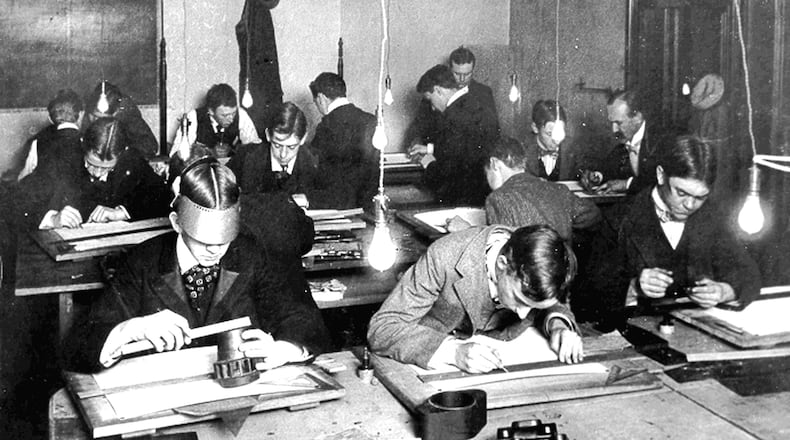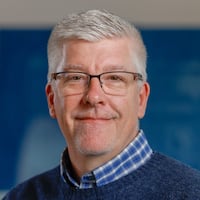Credit: Archive collection of Sinclair
Credit: Archive collection of Sinclair
Sinclair’s legacy makes it one of the oldest continuously operating community colleges in the country.
Early years
Sinclair was born in the highlands of northern Scotland. At an early age, he migrated with his parents to Hamilton, Ontario.
At age 20, he became general secretary of the Hamilton YMCA.
In that role, four years later, he traveled to Dayton for a national convention. At that same time, the Dayton board of trustees was on the lookout for a new leader and liked what they saw in Sinclair. In 1874, Sinclair agreed to take on the same roll and move to Dayton. His salary was $1,000 annually.
A building with classrooms
In 1885, the YMCA board approved construction of a new facility on East Fourth Street downtown. It was an improvement on the converted mansion they had been using since 1875.
Sinclair convinced the trustees that the young men of Dayton needed education, and they made sure the plans for the new building included classroom space.
In 1887, the new YMCA building was dedicated at 32 East Fourth Street. That year, Sinclair and E.A. Daniels, president of the YMCA, began the organization of a night school.
The building was so large, with dormitories, parlors, classrooms, a gymnasium and auditorium, that the trustees believed it would be adequate for the next 50 years. It might have been if Sinclair’s school hadn’t been so successful.
Edwin L. Shuey
Sinclair and Daniels needed someone to oversee the night school, so they recruited Edwin L. Shuey, manager of the U.B. Retail Bookshop, to become chairman of the YMCA educational committee.
Shuey’s initial reaction was that he had never seen an evening class and knew nothing about it. Sinclair had to admit he’d never seen one, either. Nonetheless, Shuey agreed to take on the job.
His role was to “determine what courses should be offered, to secure teachers to instruct the courses and to decide on and prepare announcements calculated to secure the attention and interest of youth.”
That is around the time it’s believed that Sinclair coined the phrase “Find the need and endeavor to meet it,” which remains one of the school’s mottos.
Sinclair, Shuey and others from the YMCA went to the potential students themselves to ask for advice. They visited factories and after speaking to managers and foremen, asked the workers what courses they thought should be offered at the school.
They started with 55 students and three classes offered the first year: freehand drawing, mechanical drawing and mathematics.
Credit: Archive Collection of Sinclair
Credit: Archive Collection of Sinclair
Mechanical drawing was such a new concept that there were not any textbooks on the subject.
Over the years, according to a 1946 Dayton Daily News article, Shuey “became one of Dayton ‘s most distinguished and most useful citizens.”
Early growth
Two years after the night classes started, enrollment jumped to 131 students. By 1903, it was 656 students.
At the turn of the century, as enrollment kept growing, Sinclair again suggested a new building. The trustees could see the need but didn’t have the money.
Then, in 1902, Mary Belle Eaker died and left her family home at the corner of Third and Ludlow streets to the YMCA as a site for its new building.
Sinclair planned a fund drive to raise the $250,000 needed for construction and renovations but died before he could begin raising the funds.
End of an era
For 28 years, Sinclair had worked 12 to 14 hours a day, seven days a week, for the YMCA and it began to take it’s toll on his health.
Doctors recommended he take an extended vacation. Sinclair headed out west to Colorado and died on the return trip to Dayton. He was just 52.
A local obituary at the time reported that “Dayton has lost its greatest citizen.”
The fund drive continued, and the building was completed in Sinclair’s memory in 1908.
Another move
In 1929, the YMCA and college moved to new building at 117 West Monument Ave.
More space was added in 1948 when the mansion at 113 West Monument Ave. was added.
By 1948, there were 1,195 students in the YMCA college studying 110 subjects.
World War II
World War II nearly shut down the school, since enrollment were down and much of the staff left in 1941 to fill various wartime jobs.
Then the government contracted with the school to provide courses in pilot training, machine shop skills and other defense-related subjects.
The Dayton Rotary Technical Institute at the YMCA college was formed. It was a 10-week course to “instruct young men in the use of technical equipment.”
The graduates of the school found their services in great demand, and every member of the class had a job lined up upon graduation.
In 1946, thanks to a new G.I. Bill, the demand for education was so great that the school added daytime course for the first time. More than half of the students were veterans.
Renaming the college
The school had become so big by 1948 that the YMCA board decided it needed to be called something different than “Dayton YMCA College,” so it was renamed after its founder.
Effective April 15, 1948, the Dayton YMCA college would be known as Sinclair College of the Young Men’s Christian Association of Dayton.
Going public
In 1965, a new Ohio law provided for publicly funded community colleges. Voters in Montgomery County approved a one-mill community college levy and at that time, and the YMCA transferred the college and all it’s assets to the community.
The new Sinclair Community College needed a new home, and a spot was found in downtown Dayton. Construction of the campus began in 1966.
In 1972, the new 20-acre campus was opened at 444 West Third Street. The campus had seven buildings and began classes in the fall quarter.
The current Sinclair Dayton campus includes 20 numbered buildings and one large parking structure that cover about 12 city blocks on the western edge of downtown Dayton.
Sinclair also has branch campuses in Centerville, Mason and at Wright-Patterson Air Force Base and offers online classes.
About the Author









